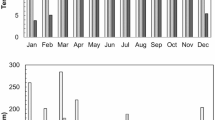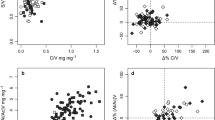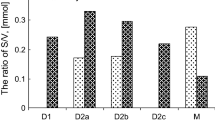Abstract
Lignin contents of mature wood growth rings formed under soil moisture extremes were determined to investigate the possibility of drought-caused reductions in lignin deposition for the southern pines. A well-defined set of slash (Pinus elliottii Engelm.), longleaf (Pinus palustris Mill.) and loblolly pine (Pinus taeda L.) increment cores were processed to excise growth rings formed during multiyear periods of above- (wet) or below-normal (drought) soil moisture. The average acid-insoluble (Klason) lignin content of the resultant drought-formed slash pine wood samples was significantly lower (31.4% vs. 34.1%; P = 0.0005) than that for the corresponding wood samples from growth rings formed under conditions of ample soil moisture; respectively higher glucan (40.6% vs. 36.9%; P = 0.0010) and mannan (11.7 vs. 10.4%; P = 0.0010) values were also observed. Small, but significant differences for other hemicellulose derived sugars (xylan, arabinan) were determined for the longleaf and loblolly pine wood samples. Altogether, these data represent the first wet chemical results showing differences in lignin and polysaccharide sugar contents for mature wood formed in pine trees during annual droughts. Among the southern pines evaluated here, slash pine is the least drought tolerant; the lower lignin content observed for the slash pine drought-formed wood is particularly intriguing since it occurred with the species most susceptible to water stress.




Similar content being viewed by others
Availability of data and material
Not applicable.
Code availability
Not applicable.
References
Adams MB, Loughry LH, Plaugher LL (2004) Revised March 2008, Experimental forests and ranges of the USDA Forest Service, Gen Tech Rep NE-321. USDA Forest Service, Northeastern Research Station, Newtown Square, PA
Albaugh TJ, Allen HL, Dougherty PM, Johnsen KH (2004) Long term growth responses of lobolly pine to optimal nutrient and water resource availability. For Ecol Manage 192:3–19
Anterola AM, Jeon J-H, Davin LB, Lewis NG (2002) Transcriptional control of monolignol biosynthesis in Pinus taeda. Factors affecting monolignol ratios and carbon allocation in phenylpropanoid metabolism. J Biol Chem 277(21):18272–18280
Anterola AM, Lewis NG (2002) Trends in lignin modification: a comprehensive analysis of the effects of genetic manipulations/mutations on lignification and vascular integrity. Phytochemistry 61:221–294
Aspinwall MJ, Li B, McKeand SE, Isik F, Gumpertz ML (2010) Prediction of whole-stem α-cellulose yield, lignin content, and wood density in juvenile and mature loblolly pine. South J Appl For 34(2):84–90
Bhuta AAR, Kennedy LM, Pederson N (2009) Climate-radial growth relationships of Northern latitudinal range margin longleaf pine (Pinus palustris P. Mill.) in the Atlantic Coastal Plain of southeastern Virginia. Tree-Ring Res 65(2):105–115
Borders BE, Harrison WM (1989) Comparison of slash pine and loblolly pine performance on cutover site-prepared sites in the Coastal Plain of Georgia and Florida. South J Appl For 13:204–207
Bouriaud O, Leban J-M, Bert D, Deleuze C (2005) Intra-annual variations in climate influence growth and wood density of Norway spruce. Tree Physiol 25:651–660
Brunow G, Lundquist K, Gellerstedt G (1999) Lignin. In: Sjöström E, Alén R (eds) Analytical methods in wood chemistry, pulping, and papermaking. Springer-Verlag, Berlin, pp 77–124
Burdon RD, Kibblewhite RP, Walker JCF, Megraw RA, Evans R, Cown DJ (2004) Juvenile versus mature wood: a new concept, orthoganol to corewood versus outerwood, with special reference to Pinus radiata and P. taeda. For Sci 50(4):399–415
Camarero JJ, Fernández-Pérez L, Kirdyanov AV, Shestakova TA, Knorre AA, Kukarskih VV, Voltas J (2017) Minimum wood density of conifers portrays changes in early season precipitation at dry and cold Eurasian regions. Trees Struct Funct 31:1423–1437
Candel-Pérez D, Lo Y-H, Blanco JA, Chiu C-M, Camarero JJ, de Andrés EG, Imbert JB, Castillo FJ (2018) Drought-induced changes in wood density are not prevented by thinning in Scots pine stands. Forests 9:4
Creber GT, Chaloner WG (1984) Influence of environmental factors on the wood structure of living and fossil trees. Bot Rev 50(4):357–448
Cregg BM, Dougherty PM, Hennessey TC (1988) Growth and wood quality of young loblolly pine trees in relation to stand density and climatic factors. Can J For Res 18:851–858
Cuny HE, Rathgeber CBK, Frank D, Fonti P, Fournier M (2014) Kinetics of tracheid development explain conifer tree-ring structure. New Phytol 203:1231–1241
Davis MW (1998) A rapid modified method for compositional carbohydrate analysis of lignocellulosics by high pH anion-exchange chromatography with pulsed amperometric detection (HPAEC/PAD). J Wood Chem Tech 18(2):235–252
Deng Y, Lu S (2017) Biosynthesis and regulation of phenylpropanoids in plants. Crit Rev Plant Sci 36(4):257–290
Devall MS, Grender JM, Koretz J (1991) Dendroecological analysis of a longleaf pine Pinus palustris forest in Mississippi. Vegetatio 93:1–8
Domec J-C, Gartner BL (2002) How do water transport and water storage differ in coniferous earlywood and latewood? J Exp Bot 53(379):2369–2379
Donaldson LA (2002) Abnormal lignin distribution in wood from severely drought stressed Pinus radiata trees. IAWA J 23(2):161–178
Eberhardt TL (2012) Impact of industrial source on the chemical composition of loblolly pine bark. For Prod J 62(7/8):516–519
Eberhardt TL, Samuelson LJ (2015) Collection of wood quality data by X-ray densitometry: a case study with three southern pines. Wood Sci Technol 49:739–753
Eberhardt TL, So C-L, Leduc DJ (2019) Wood property maps showing wood variability in mature longleaf pine: does getting old change juvenile tendencies? Wood Fib Sci 51(2):193–208
Effland MJ (1977) Modified procedure to determine acid-insoluble lignin in wood and pulp. Tappi 60(10):143–144
Fox TR, Jokela EJ, Allen HL (2007) The development of pine plantation silviculture in the southern United States. J For 105(7):337–347
Frelin O, Dervinis C, Wegrzyn JL, Davis JM, Hanson AD (2017) Drought stress in Pinus taeda L. induces coordinated transcript accumulation of genes involved in the homogentisate pathway. Tree Genet Genom 13:27
Frost CC (1993) Four centuries of changing landscape patterns in the longleaf pine ecosystem. In: Hermann SM (ed) Proceedings of the 18th Tall Timbers fire ecology conference. Tall Timbers Research Station, Tallahassee, FL, pp 14–43
Gindl W (2001) Cell wall lignin content related to tracheid dimensions in drought-sensitive Austrian pine (Pinus nigra). IAWA J 22(2):113–120
Gonzalez-Benecke CA, Martin TA, Clark A III, Peter GF (2010) Water availability and genetic effects on wood properties of loblolly pine (Pinus taeda). Can J For Res 40:2265–2277
Gonzalez-Benecke CA, Riveros-Walker AJ, Martin TA, Peter GF (2015) Automated quantification of intra-annual density fluctuations using microdensity profiles of mature Pinus taeda in a replicated irrigation experiment. Trees Struct Funct 29:185–197
González-Martínez SC, Wheeler NC, Ersoz E, Nelson CD, Neale DB (2007) Association genetics in Pinus taeda L. 1. Wood Property Traits Genet 175:399–409
Graham JH, Duda JJ, Brown ML, Kitchen S, Emlen JM, Malol J, Bankstahl E, Krzysik AJ, Balbach H, Freeman DC (2012) The effects of drought and disturbance on the growth and developmental instability of loblolly pine (Pinus taeda L.). Ecol Indic 20:143–150
Hart J, O’Keefe K, Augustine SP, McCulloh KA (2020) Physiological responses of germinant Pinus palustris and P taeda seedlings to water stress and the significance of the grass-stage. For Ecol Manage 458:117647
Henderson JP, Grissino-Mayer HD (2009) Climate-tree growth relationships of longleaf pine (Pinus palustris Mill.) in the southeastern Coastal Plain, USA. Dendrochronologia 27:31–43
Hennessey TC, Dougherty PM, Lynch TB, Wittwer RF, Lorenzi EM (2004) Long-term growth and ecophysiological responses of a southeastern Oklahoma loblolly pine plantation to early rotation thinning. For Ecol Manage 192:97–116
Hori C, Takata N, Lam PY, Tobimatsu Y, Nagano S, Mortimer JC, Cullen D (2020) Identifying transcription factors that reduce wood recalcitrance and improve enzymatic degradation of xylem cell wall in Populus. Sci Rep 10:22043
Jokela EJ, Dougherty PM, Martin TA (2004) Production dynamics of intensively managed loblolly pine stands in the southern United States: a synthesis of seven long-term experiments. For Ecol Manage 192:117–130
Jones JKN, Painter TJ (1957) The hemicelluloses of loblolly (Pinus taeda) wood. Part 1. The isolation of five oligosaccharide fragments. J Chem Soc 669–673
Jones JKN, Painter TJ (1959) The hemicelluloses of loblolly (Pinus taeda) wood. Part 2. The constitution of hexosan and pentosan components. J Chem Soc 573–580
Jones PD, Schimleck LR, Peter GF, Daniels RF, Clark A III (2006) Nondestructive estimation of wood chemical composition of sections of radial strips by diffuse reflectance near infrared spectroscopy. Wood Sci Technol 40:709–720
Kibblewhite RP (1999) Designer fibres for improved papers through exploiting genetic variation in wood microstructure. Appita J 52(6):429–435
Kubler H (1980) Wood as building and hobby material. John Wiley and Sons, New York
Kush JS, Meldahl RS, McMahon CK, Boyer WD (2004) Longleaf pine: a sustainable approach for increasing terrestrial carbon in the southern United States. Environ Manage 33(Supplement 1):S139–S147
Lachenbruch B, Moore JR, Evans R (2011) Radial variation in wood structure and function in woody plants, and hypotheses for its occurrence. In: Meinzer FC, Lachenbruch B, Dawson TE (eds) Size- and age-related changes in tree structure and function. Springer, Berlin, pp 121–164
Landers JL (1991) Disturbance influence on pine traits in the southeastern United States. In: Hermann SM (ed) Proceedings 17th Tall Timbers fire ecology conference. Tall Timbers Research Station, Tallahassee, FL, pp 61–98
Lantz CW (1987) Which Southern pine species is best for your site? Forest Farmer 47(1):11–12
Larson PR (1969) Wood formation and the concept of wood quality. Yale University, School of Forestry Bulletin No. 74. Yale University, New Haven, CT
Larson PR, Kretschmann DE, Clark A III, Isebrands JG (2001) Formation and properties of juvenile wood in the Southern pines: a synopsis. Gen Tech Rep FPL-GTR-129. USDA Forest Service, Forest Products Laboratory, Madison, WI
Maeda HA (2019) Harnessing evolutionary diversification of primary metabolism for plant synthetic biology. J Biol Chem 294(45):16549–16566
Manzanedo RD, Pederson N (2019) Towards a more ecological dendroecology. Tree-Ring Res 75(2):152–159
Mayer K, Grabner M, Rosner S, Felhofer M, Gierlinger N (2020) A synoptic view on intra-annual density fluctuations in Abies alba. Dendrochonologia 64:125781
Meldahl RS, Pederson N, Kush JS, Varner JM III (1999) Dendrochronological investigations of climate and competitive effects on longleaf pine growth. In: Wimmer R, Vetter RE (eds) Tree-ring analysis: biological, methodological, and environmental aspects. CABI Publishing, London, pp 265–285
Nix LE, Villiers K (1985) Tracheid differentiation in Southern pines during the dormant season. Wood Fib Sci 17(3):397–403
Novaes E, Kirst M, Chiang V, Winter-Sederoff H, Sederoff R (2010) Lignin and biomass: a negative correlation for wood formation and lignin content in trees. Plant Physiol 154:555–561
Outcalt KW, Sheffield RM (1996) Tapping the trees: the naval stores industry in the American South. Louisiana State University Press, Baton Rouge, LA
Palmer WC (1965) Meteorological drought. US Department of Commerce Weather Bureau, Research Paper No. 45, Washington, DC
Panshin AJ, de Zeeuw C (1980) Textbook of wood technology, 4th edn. McGraw-Hill, New York
Pascual MB, El-Azaz J, de la Torre FN, Canas RA, Avila C, Cánovas FM (2016) Biosynthesis and metabolic fate of phenylalanine in conifers. Front Plant Sci 7:1030
Pattathil S, Ingwers MW, Victoriano OL, Kandemkavil S, McGuire MA, Teskey RO, Aubrey DP (2016) Cell wall ultrastructure of stem wood, roots, and needles of a conifer varies in response to moisture availability. Front Plant Sci 7:882
Plomion C, Leprovost G, Stokes A (2001) Wood formation in trees. Plant Physiol 127:1513–1523
Rajan K, Djioleu A, Kandhola G, Labbé N, Sakon J, Carrier DJ, Kim J-W (2020) Investigating the effects of hemicellulose pre-extraction on the production and characterization of loblolly pine nanocellulose. Cellulose 27:3693–3706
Rathgeber CBK, Cuny HE, Fonti P (2016) Biological basis of tree-ring formation: a crash course. Front Plant Sci 7:734
Rosner S, Gierlinger N, Klepsch M, Karlsson B, Evans R, Lundqvist S-O, Svétlík J, Børja I, Dalsgaard L, Andreassen K, Solberg S, Jansen S (2018) Hydraulic and mechanical dysfunction of Norway spruce sapwood due to extreme summer drought in Scandinavia. For Ecol Manage 409:527–540
Rowell RM, Pettersen R, Tshabalala MA (2013) Cell wall chemistry. In: Rowell RM (ed) Handbook of wood chemistry and wood composites, 2nd edn. CRC Press, Boca Raton, FL, pp 33–72
Runion GB, Entry JA, Prior SA, Mitchell RJ, Rogers HH (1999) Tissue chemistry and carbon allocation in seedlings of Pinus palustris subjected to elevated atmospheric CO2 and water stress. Tree Physiol 19:329–335
Samuels AL, Kaneda M, Rensing KH (2006) The cell biology of wood formation: from cambial divisions to mature secondary xylem. Can J Bot 84:631–639
Samuelson LJ, Stokes TA, Johnsen KH (2012) Ecophysiological comparison of 50-year-old longleaf pine, slash pine and loblolly pine. For Ecol Manage 274:108–115
Schenck CA, Maeda HA (2018) Tyrosine biosynthesis, metabolism, and catabolism in plants. Phytochemistry 149:82–102
Schmidtling RC (1973) Intensive culture increases growth without affecting wood quality of young southern pines. Can J For Res 3:565–573
Schultz RP (1999) Loblolly—the pine for the twenty-first century. New For 17:71–88
South DB, Harper RA (2016) A decline in timberland continues for several Southern yellow pines. J For 114(2):116–124
Stanturf JA, Wade DD, Waldrop TA, Kennard DK, Achtemeier GL (2002) Fire in Southern forest landscapes. In: Wear DM, Greis JG (eds) Southern forest resource assessment. Gen Tech Rep SRS-53. USDA Forest Service, Southern Research Station, Asheville, NC, pp 607–630
Tuskan G, West D, Bradshaw HD, Neale D, Sewell M, Wheeler N, Megraw B, Jech K, Wiselogel A, Evans R, Elam C, Davis M, Dinus R (1999) Two high-throughput techniques for determining wood properties as part of a molecular genetics analysis of hybrid poplar and loblolly pine. Appl Biochem Biotechnol 77–79:55–65
Uggla C, Magel E, Moritz T, Sundberg B (2001) Function and dynamics of auxin and carbohydrates during earlywood/latewood transition in Scots pine. Plant Physiol 125:2029–2039
Vanholme R, De Meester B, Ralph J, Boerjan W (2019) Lignin biosynthesis and its integration into metabolism. Curr Opin Biotech 56:230–239
Via BK, So C-L, Groom LH, Shupe TF, Stine M, Wikaira J (2007) Within tree variation of lignin, extractives, and microfibril angle coupled with the theoretical and near infrared modeling of microfibril angle. IAWA J 28(2):189–209
Vogt T (2010) Phenylpropanoid biosynthesis. Mol Plant 3(1):2–20
Wang Y, Chantreau M, Sibout R, Hawkins S (2013) Plant cell wall lignification and monolignol metabolism. Front Plant Sci 4:220
Wear D, Greis J (2002) Southern forest resource assessment. Gen Tech Rep SRS-53. USDA Forest Service, Southern Research Station, Asheville, NC
Xie M, Zhang J, Tschaplinski TJ, Tuskan GA, Chen J-G, Muchero W (2018) Regulation of lignin biosynthesis and its role in growth-defense tradeoffs. Front Plant Sci 9:1427
Zobel BJ, Sprague JR (1998) Juvenile wood in forest trees. Springer-Verlag, Berlin
Zubizarreta-Gerendiain A, Gort-Oromi J, Mehtätalo L, Peltola H, Venäläinen A, Pulkkinen P (2012) Effects of cambial age, clone and climatic factors on ring width and ring density in Norway spruce (Picea abies) in southeastern Finland. For Ecol Manage 263:9–16
Acknowledgements
The authors are grateful to Fred J. Matt (USDA Forest Service, Forest Products Laboratory) for the lignin and sugar analyses. Gratitude is also extended to Daniel J. Leduc for assistance with the statistical analyses.
Funding
Not applicable.
Author information
Authors and Affiliations
Corresponding author
Ethics declarations
Conflict of interest
On behalf of all authors, the corresponding author states that there is no conflict of interest.
Ethical approval
Not applicable.
Consent to participate
Not applicable.
Consent for publication
Not applicable.
Additional information
Publisher's Note
Springer Nature remains neutral with regard to jurisdictional claims in published maps and institutional affiliations.
Rights and permissions
About this article
Cite this article
Eberhardt, T.L., Samuelson, L.J. Comparison of lignin and polysaccharide sugar contents for slash, longleaf, and loblolly pine growth rings formed during periods of soil moisture extremes. Wood Sci Technol 56, 389–408 (2022). https://doi.org/10.1007/s00226-022-01359-0
Received:
Accepted:
Published:
Issue Date:
DOI: https://doi.org/10.1007/s00226-022-01359-0




